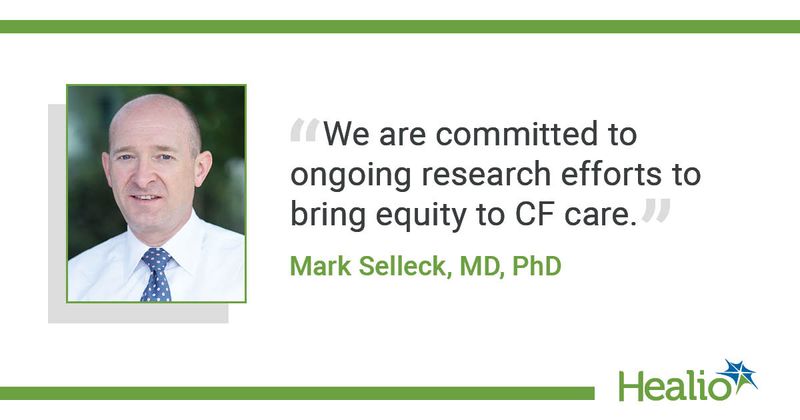Q&A: Behind the scenes of CF care at Children’s Hospital Los Angeles
Key takeaways:
- The Cystic Fibrosis Center at Children’s Hospital Los Angeles cares for a diverse group of patients.
- A multidisciplinary care team is needed in CF care since it is a multisystem disease.
With the recent addition of two pediatric pulmonologists, the Cystic Fibrosis Center at Children’s Hospital Los Angeles continues to advance research on this disease, especially for children from diverse racial and ethnic backgrounds.
According to a press release from the hospital, its diverse patient population allows for more participation in clinical trials that evaluate CF treatments. It is critical that patients from all backgrounds are represented in these trials due to differing CF mutations that impact treatment eligibility.

The CF Center also houses a multitude of specialists that provide care for more than 140 patients. In addition to physicians from specialties other than pulmonology, the center has a nurse care manager, dietitians, psychologists and more.
To learn more about the CF Center’s role in researching treatments, recent advancements in CF care and the benefits of a multidisciplinary care team, Healio spoke with Mark Selleck, MD, PhD, director of the Cystic Fibrosis Center in the division of pulmonology and sleep medicine at Children’s Hospital Los Angeles.
Healio: What role has the Cystic Fibrosis Center at Children’s Hospital Los Angeles played in researching treatments for CF?
Selleck: Children’s Hospital Los Angeles has a long history of participation in sponsored clinical research evaluating the efficacy of new treatments for CF. We have been a center within the Therapeutic Development Network of the Cystic Fibrosis Foundation for many years and have played instrumental roles in investigating new medications, such as the highly effective modulator therapies.
We continue our participation as a Therapeutic Development Center under the leadership of Martha McKinney, MD, MPH, FRCPC, associate director of the Cystic Fibrosis Clinic, and are excited about the possibility of participating in studies into genetic therapies in the future.
Healio: What is your background in treating/studying CF in children? How have you built on this while working at the Cystic Fibrosis Center?
Selleck: While I have been taking care of patients with CF for many years, I only became the CF Care Center director within the past year, having succeeded Thomas Keens, MD, a leader in pediatric pulmonology and CF.
Together with McKinney and Whitney Gore, RN, BSN, nurse coordinator at the CF Center, we continue to build upon Keens’s impressive legacy by supporting the efforts of an exceptional team of diverse professionals in research and quality improvement projects.
As a pediatric pulmonology fellowship training program, we are responsible for the education and development of the next generation of physicians who will be responsible for taking care of people with CF, and in this regard, we are building a strong curriculum in CF care.
Healio: What recent advancements in CF care/treatment should clinicians know about/keep an eye out for?
Selleck: Each year that passes seems to bring significant advances in the treatment of CF through the development of new antimicrobial drugs, devices for airways clearance and, most importantly, highly effective modulator therapies (HEMT).
The latter are a group of medications which correct the underlying abnormality in CFTR synthesis, processing or function. Elexacaftor/tezacaftor/ivacaftor (Trikafta, Vertex Pharmaceuticals) in particular has been transformational for many patients with CF, but unfortunately is not a cure and cannot be used to treat all patients. New HEMTs are constantly under development and the next few years will see new medications being brought to clinical use.
The most exciting prospects are for genetic therapies, which have the potential to correct CFTR function regardless of the mutation, and thus could be used for those patients currently ineligible for current modulators.
Healio: What are some benefits of working on a multidisciplinary care team? How does this type of team also benefit patients?
Selleck: CF is a multisystem disease and requires a multidisciplinary approach, and the care of patients has been team-based for many years, with each team member contributing their unique perspectives and expertise.
At Children’s Hospital Los Angeles, we have a superb team which consists of physicians (pediatric pulmonary, gastroenterology, infectious diseases) and an advanced practice provider, along with a nurse care manager, CF coordinator, pharmacist, dietician, respiratory therapist, clinical social worker, psychologist and clinical research professionals. We hope to add a pediatric endocrinologist to our team in the near future.
The patients benefit from such a synergistic approach. From a personal perspective, it is an incredible experience to work alongside highly motivated and compassionate colleagues, and we support each other in myriad ways.
Healio: What are your goals while working as a part of the Cystic Fibrosis Center?
Selleck: Children’s Hospital Los Angeles is unique among CF Care Centers in the demographics of our patients. Over 50% of our patients are Latino/Hispanic, and the CFTR mutations in this population make many ineligible for current CFTR modulator therapies.
We are committed to ongoing research efforts to bring equity to CF care, in addition to providing superlative care to all patients followed in our center.
Reference:
- Developing new approaches for children with cystic fibrosis. https://www.chla.org/blog/experts/research-and-breakthroughs/developing-new-approaches-children-cystic-fibrosis. Published Jan. 26, 2024. Accessed March 7, 2024.
